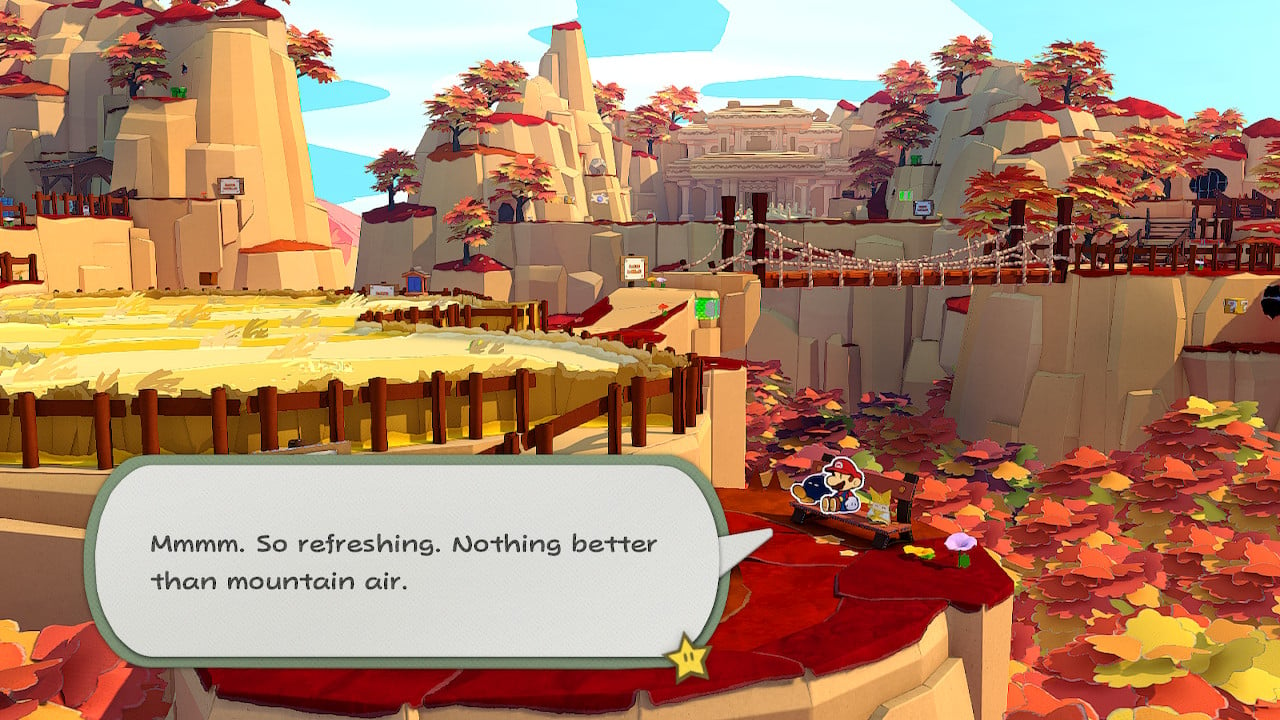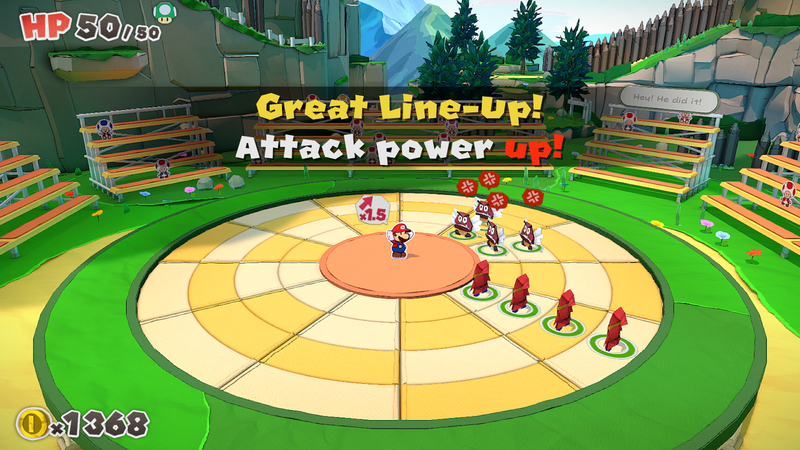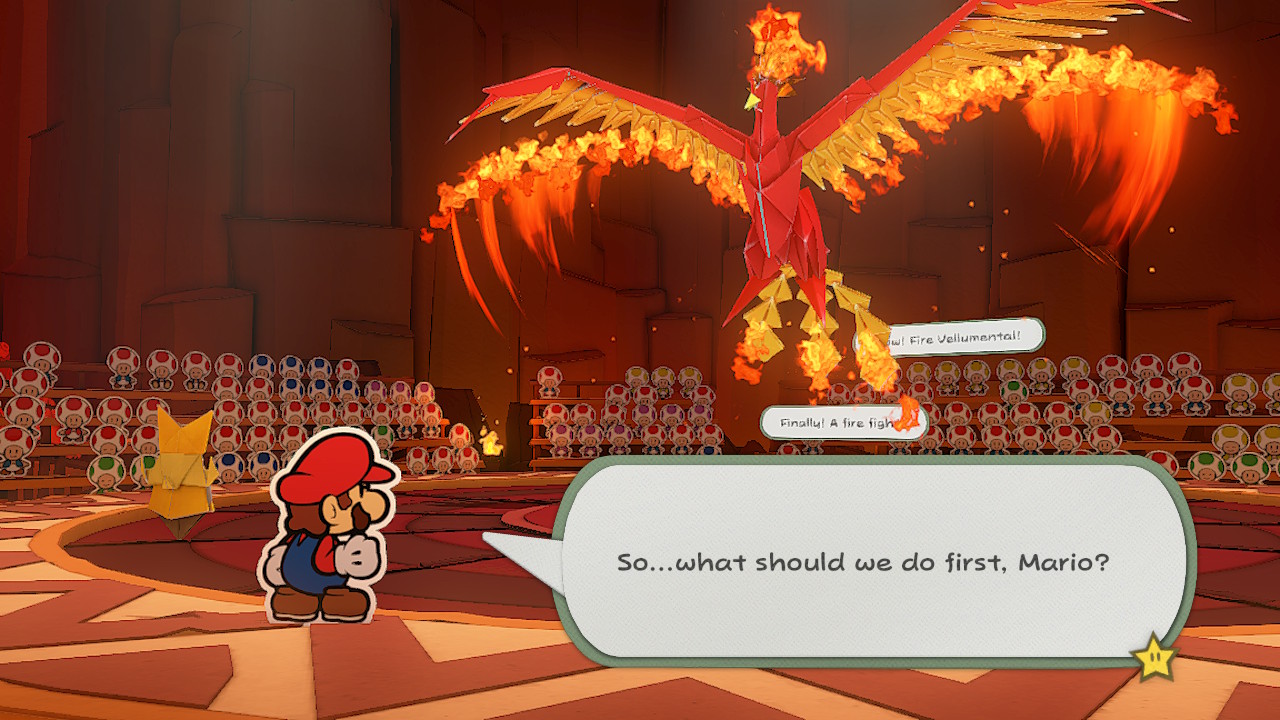For the 20 years since its debut, the Paper Mario series has changed itself multiple times and become something of an anomaly in the plumber’s history. Initially a simple RPG with a unique art style, it would go on to embrace and expand on those roots with unique (particularly for a Mario game) characters and storylines. Eventually it would dial back on those features and double down on the ‘Paper’ angle, filling the games with diorama environments and “real” objects.
And Toads. Many, many nondescript Toads.
Here we are though, with the Switch debut of this stationery series. The core motif in this fifth full entry is folding, building up from “Stickers” and “Color” to embrace its subtitle with aplomb. Paper Mario: The Origami King has comfortably built itself upwards from those two games and become something even more enjoyable. The throughlines of the entire series, such as the writing and especially the presentation, are crafted around some new gameplay ideas — not all of which work.
So no, this isn’t the grand return of partners you might’ve hoped for, and the game drifts even further away from RPG territory towards a focus on exploration. It even carries a few of the flaws of its more immediate predecessors rather than learn from them. What it does, though, is provide a great time throughout while making the most of its unique world.

That world is one of the biggest selling points of Origami King, though one its marketing hasn’t exactly spotlighted. Unlike previous entries in the series, this Paper Mario features some more expansive and frankly impressive locales. These bigger maps are rife with hidden Toads (often folded into origami) and ? Blocks to uncover, and have a sense of scale and continuity due to the giant streamers in their skies that trail back to an uprooted Peach’s Castle.
Exploring these areas, along with the story and writing, were what kept me engaged with the game. Moving from area to area meant a regular rotation of Toads and treasures to uncover, which the game helpfully keeps a count of for each location. It pushes the game into collectathon-lite territory, and while I wouldn’t choose that over a more fleshed out RPG system in this case, it still carried my time with the game well.

In particular, it’s when the game plays with expectations and tries new things that it’s at its best. The first area of the game is a pretty standard opener with forests and green hills to ease you into adventure, but deeper in you’ll find a full Japanese historic theme park experience and a seafaring adventure with vibes of the Wind Waker’s Great Sea. It presents a take on the Mushroom Kingdom that’s unique and vibrant, though without the cast to back it up.
Don’t get me wrong, as that doesn’t mean that Origami King is lacking in the writing department. Even with hundreds of oft-identical Toads, they manage to say things both funny and even thought provoking, and the same can be said for other NPCs as well. It’s just that the brunt of the adventure is spent with just Mario and newcomer Olivia. She’s a delight, and even gets some genuine character moments that are emotional high points for the game, but she’s mostly the exception.
Initial trailers had fans’ hopes up that partners would make a return to Paper Mario on Switch, and while you do pal around with allies they’re fairly static for the time you spend with them, lacking both visual flair and deeper characterization. That’s nothing new for the series, as many of the N64 partners lacked intrigue and the Super Paper Mario Pixls were barely characters, but it’s unfortunate that Origami King’s pals are similarly lacking. It is worth mentioning, though, that some of the game’s more memorable moments are directly tied to them and I couldn’t help but get excited when I realized I’d be making a new friend.
You know what would almost always ruin that enthusiasm, though?
The battles.

Paper Mario: The Origami King continues the questionable practice of making battles practically insignificant. Mario gains no EXP from these encounters, with the only rewards being coins and confetti. Those two pickups aren’t frequently tied to progression, with seemingly enough being findable through other means to cover mandatory costs and pitfalls. So why fight? The only real reward would be the fighting itself, which, while unique, is more often a chore or roadblock than a compliment to the exploration.
Rotating and sliding panels in these unique battles to arrange the enemies is interesting, and as a fan of puzzle games I took to the challenge. Yet the game never truly goes anywhere with this mechanic for standard fights. Early on they’re ridiculously easy (and Olivia even guides you through your first handful), while later in the game they become more difficult but have overstayed their welcome. This created a sweet spot for a while, but for the majority of my time with Origami King I avoided fights altogether.
There are features present in the battles that add extra wrinkles, like various weapons and items you can use and the option to pay Toad audience members for help, but there’s no real depth or reward. You hop and hammer-bop the whole way through, with partners sometimes throwing out an attack of their own to help.
Boss fights, on the other hand, get a little more creative, having you guide Mario along the rings of the battlefield to step on various panels and take the corresponding action. Combined with the bosses’ own variety in terms of weaknesses or attack patterns, these were much more welcome and measured out in a way where they didn’t become frustrating. Some aren’t as enjoyable (in one notable instance, thanks to a misclick, the boss ended up healing itself back up to full when I’d whittled it down to its last bit of health) but to their credit they break things up in a more welcome and unique way.

I’ve thrown a lot of criticism at this game, and I’m definitely of the mind that I’d like more of the older style of Paper Mario. Yet I haven’t been able to stop playing, and it continues to delight me in so many other ways. The series has never looked better, fully embracing its cardboard diorama look and bright colors. Autumnal hillsides and desert casinos come to life, made even more delightful by the comments from NPCs.
You’ll want to talk to everyone too. Origami King is a rare breed of game where while not always useful, its background characters more often than not say something amusing. Some jokes or references or existential musings hit better than others, but they drive you to want to see and do more in this world better than any fight could. This is a game you want to revel in, not toil through, and it pains me that it couldn’t strike that balance better.
Each streamer section of the game felt more interesting than the last, though I will admit they all adhere to a certain template. Mario and Olivia head to a new area, maybe meet a new friend, enter a temple to get a power, that power helps them enter another area, and ultimately they wrap things up by fighting an animate inanimate object, leaving you to deal with collectible completion as you like. That too is a qualm not unique to Origami King, but it’s one made more apparent by the other mentioned wrinkles (creases?) of the game.

So while I can safely say this game drew me in and has been the perfect dose of colorful cheer for a not so bright time in the world, I wouldn’t recommend it to anyone stuck on the series’ RPG roots. To those same people though, I’d want to make clear that we’ve come a long way since Sticker Star. This is the perfect time to give Paper Mario a chance with a clear mind and suite of expectations, because it’s hit a stride in many of its aspects. Even if you miss badges so much it hurts, give this one a try.
If you’re coming in here without much prior attachment to the series, then congratulations, you get the much more straightforward response of “yes, it’s fun, play it.” It may not deliver in certain respects, and the admittedly interesting battles become a letdown, but around those shortcomings is a game full of charm and humor. When the confetti’s done flying it might not stand with the must-haves of the Switch’s library, but Paper Mario: The Origami King is a satisfying and entertaining bibliofold of a game.
Leave a Comment

System: Nintendo Switch
Release Date: July 17, 2020
Categories: Adventure
Publisher: Nintendo
Developer: Intelligent Systems


